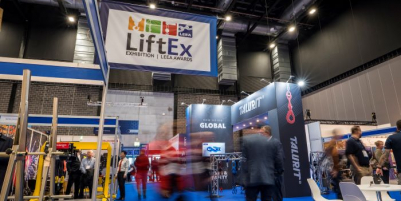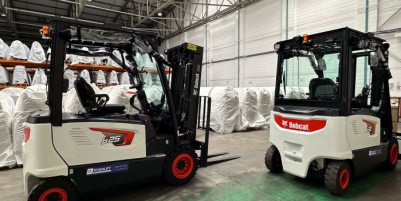-
Women Leading the Way in the UK Material Handling Industry - December 12, 2025
-
LiftEx 2025 live from Liverpool - December 11, 2025
-
DATA ANALYSIS – THE FOUNDATION OF EVERY PEAK SEASON - December 5, 2025
-
Creative education specialists Creative Hut give 3PL full marks for onboarding excellence - December 5, 2025
-
Unlimited Industries raises $12M to build the AI construction company that will power America’s future - December 4, 2025
-
Scottish Leather Group gets full-support solution from Rushlift - December 4, 2025
-
Etaily lands strategic investment from Japan’s SMBC – bringing total funding to $24M for Social Commerce enablement platform - December 4, 2025
-
Winners lift their LEEA Awards and raise the industry - December 4, 2025
-
Prism eLogistics and Brand Angels Partnership Gives Brands the Full Package - December 3, 2025
-
New data shows Tesla in danger of losing its way as European consideration to buy Chinese cars jumps 16% in 12 months - December 3, 2025
This article covers multiple-CAN communication protocols of battery management systems (BMS) with the host vehicle, the charger, other externally connected devices, and battery components.
With the switch to lithium batteries, the efficiency and safety of materials-handling equipment and other off-highway and industrial electric vehicles are improving. But to fully realize the potential of new lithium technology, there must be constant, reliable communication between the power source and the vehicle, the truck, the charger, and other system components. Improvements in battery management and communication protocols are the front line of innovation and product improvements in industrial batteries.
What is a CAN?
CAN stands for controller area network. From automotive to industrial control industries, this communication protocol is common and widely used.
CANs are used in forklift battery management systems. These networks allow the various electronic components of a forklift to communicate with the battery and relay information. Forklift battery CAN integration guarantees that the battery and the host truck or charger are working as one system and exchange all necessary data.

OneCharge lithium battery BMS module
A BMS monitors the state of the battery on the cell and pack levels, controls power output, and optimizes the performance of individual cells. CANs connect the BMS to all the battery sensors and to the forklift controls and indicators.
One of the main benefits of using a CAN in a BMS for forklifts is that it allows for real-time communication between the various components of the truck/battery/charger system. This is important for ensuring that the forklift is operating safely and efficiently. For example, the BMS can monitor the state of charge of the battery and send this information to the forklift controller, which can then adjust the power output of the forklift to ensure that it is running at optimal performance.
Other important data that a truck receives from a CAN-integrated battery include its temperature and voltage both at a cell and a pack level. BMSs can use information from the battery sensors to adjust the charging rate of the battery or to provide alerts to the driver if the battery is approaching a low state of charge.
CANs help improve the reliability of the battery system by adding protection from noise and errors. This means better syncing of the cells, longer cycle life, and, as a result, lower downtime and a reduced possibility of system failure. Where productivity matters, dependable BMSs with CAN communication can make a big difference.
CAN insulation is used in materials handling applications for advanced data protection in often adverse environments: lots of electronic equipment, vibration, powerful electric motors with their own electromagnetic interference, etc.
How Many CANs Are Used in the Same BMS?
BMSs may use CANs to connect to a power management block; indicators; current, and other sensors; start/stop systems; built-in chargers; battery cooling and heating systems; battery pack controls; and discharge ports for other gadgets.
A BMS is not required to have a CAN integration and communication protocol with a truck or a charger, and some don’t have any. Some batteries have just one CAN to connect with the truck. Others have two parallel CAN connections: one to the fork truck and the other to the charger.
It is possible to use two or more CANs in a battery management system to work with a forklift and charger. In such a system, each CAN would typically serve a different purpose and communicate with a different set of components.
Advanced forklift batteries may feature multiple CAN connections as part of their BMS. For example, OneCharge developed a multi-CAN BMS that connects the battery, the truck, the charger, and all the internal elements and components of the battery pack itself. Other connections are reserved for outside equipment, like an outside battery discharge indicator (BDI). CAN integration capabilities are very important to fully realize the potential of the technology and increase equipment utilization.
Multiple CANs can also be used to prevent interference. For example, the charger and forklift can be on separate CAN networks to reduce interference from other components.
What is a CAN Gateway?
Two or more CAN networks can communicate with each other within a BMS using a CAN gateway. The CAN gateway works like a bridge between two or more distinct CANs.
CAN networks translate messages from one CAN to another in a compatible format, using rules created by the system designer; this is known as a CAN interface.
With the help of multiple CAN networks and a CAN gateway to manage communication between applicable networks, various components can share information, and coordinate actions. This improves the performance and dependability of the system as well.
Key BMS Features to Consider When Choosing a Forklift Battery
An advanced BMS provides improved safety, reliability, and longer battery life through constant optimization of the performance of individual cells and the battery pack. What features should you consider when finding the right BMS? The following factors are key.
Monitoring and control capabilities. A good BMS is always equipped with these capabilities, whether it’s the ability to adjust charging rate or discharging rate, or monitoring temperature, charge, and voltage of batteries.
Charger parameters and settings: battery compatibility, voltage, energy throughput, charging rate, and the like.
Value. Consider the BMS’s feature set, performance, reliability, and other relevant factors in assessing the cost to value tradeoff.
Data capabilities. Wi-Fi and cellular options for connection to the central router and cloud database, remote troubleshooting and diagnostics, and data presentation in a user interface are all important parts of the product.
Some examples of lift truck models that may have CANs include:
- Toyota forklifts: Many Toyota forklifts use CANs to connect electronic components such as the engine control unit and transmission control unit.
- Hyster forklifts: Hyster forklifts use CANs to connect various electronic components such as the engine control unit, transmission control unit, and steering system.
- Caterpillar forklifts: Caterpillar forklifts use CANs to connect various electronic components such as the engine control unit, transmission control unit, and steering system.
- Linde forklifts: Linde forklifts use CANs to connect various electronic components such as the engine control unit, transmission control unit, and steering system.
Conclusion
The electronics of battery management systems—a battery’s electronic “brain”— are developing rapidly, far more so than improvements in battery cells and chemistry. CAN connections between the BMS, the elements of the battery system, and external devices play the most significant role in the product development of forklift batterie

































